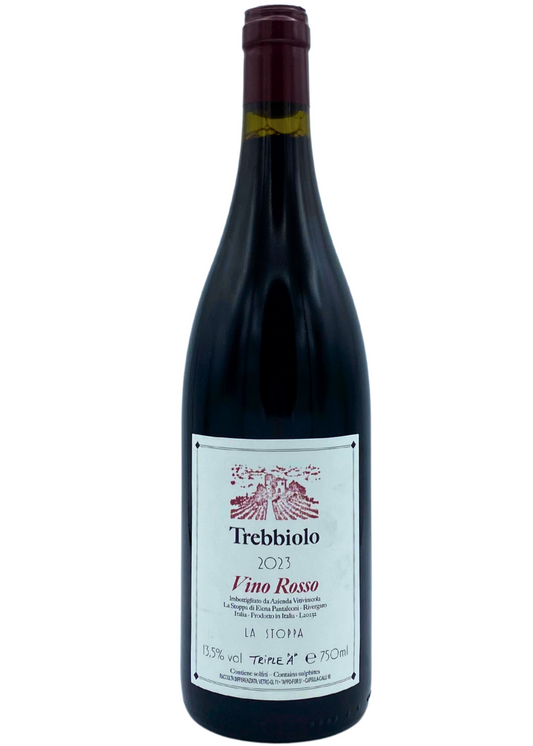AGRICOLA LA STOPPA
ELENA PANTALEONI
Emilia-Romagna, Italy
La Stoppa’s property sits on the slopes of Val Trebbiola, in the Emilia-Romagna region, in Northern Italy. The Estate was founded in the late 19th century. In 1973 La Stoppa was bought by the Pantaleoni family. Since 1991 Elena Pantaleoni has led the Estate, focusing on working organically in the vineyards and drastically changing the winemaking since her arrival.
QUICK FACTS
ESTABLISHMENT
1973
AREA
58 hectares – 30 hectares are planted with vines, with 28 hectares left to nature.
GRAPES
Barbera and Bonarda for red grapes, Malvasia di Candia Aromatica, Ortrugo and Trebbiano for white grapes.
SOILS
Heavy clay
VINES
Average about 30 years
WINEMAKING STYLE
The cultivation process is all done by hand - pruning, tying, removing non-fruit-bearing buds, and harvest - to ensure that greater attention is given to the quality of the grape selection. The grapes from the younger vines are used for the production of young wines and the finest grapes and older vines are used for the production of long-aging wines.
All the wines are fermented in stainless steel and concrete vats, then racked to a variety small and large oak barrels for aging.
FUN FACTS
In the second half of the nineteenth century, a lawyer named Giancarlo Ageno discovered the place to be apt for winemaking and started the production of wines with significant and curious names such as Bordò, Bordò bianco, Pinò.
AGRICOLA LA STOPPA LOCATION
-
La Stoppa Macchiona dieciannidopo 2002
Regular price From HK$590.00Regular priceUnit price / per -
La Stoppa Riostoppa 2017
Regular price HK$390.00Regular priceUnit price / per -
La Stoppa Trebbiolo 2023
Regular price HK$240.00Regular priceUnit price / per -
La Stoppa Camporomano 2013
Regular price HK$370.00Regular priceUnit price / per
BACKGROUND OF NATURAL WINE IN EMILIA-ROMAGNA
Located in northern Italy, Emilia-Romagna is a renowned region known for its rich culinary heritage and diverse wine production. Have you heard of Parmigiano Reggiano, Prosciutto di Parma, balsamic vinegar or Lasagne all Bolognese? They all come from this region! Emilia is mostly flat, dominated by Italy's longest river - Fiume Po - and by Italy's largest flatland, called Pianura Padana, the most fertile agricultural region of the peninsula. With its fertile plains and favorable climate, Emilia-Romagna continues to be a significant contributor to Italy's wine culture and gastronomic reputation. In terms of wine production, it is best known for its sparkling Lambrusco.
Organic, Biodynamic and Natural wine. What’s the difference?
To understand this concept and its various ramifications, it is necessary to keep something clear in mind: before the 20th century and the spreading of affordable synthetic fertilisers, all farming was organic. When the shift to the use of synthetics and pesticides happened, it became necessary to diversify traditional organic farming from the new modern farming.
ORGANIC WINE
Simply put, organic farming forbids the use of synthetic fertilisers, synthetic pesticides, herbicides, or genetically modified organisms. The basic requirements are generally specific and engage the farmers not to use any chemical fertilisers and other synthetic products in the vineyard. It does not prevent the vintner from using the conventional winemaking process after harvesting.
BIODYNAMIC WINE
Let’s take organic farming one step further: Biodynamic. The creator of this agricultural system is the Austrian philosopher Rudolf Steiner, who developed the principles of biodynamics in a series of lectures given in 1924 in Germany. Here lies the foundation of true organic wines, with a strict limit in the use of additives, stringent requirements and at the end obtaining a biodynamic certification.
NATURAL WINE
The previous definitions are usually, and rightfully, associated with it, because most natural wine is also organic and/or biodynamic. But not vice versa!
Natural wine is wine in its purest form, simply described as nothing added, nothing taken away, just grapes fermented. No manipulation whatsoever, minimal intervention both in the vineyards and in the winery. Healthy grapes, natural yeast and natural fermentation, with no filtration nor fining. Sounds easy, right? However, making natural wine is unforgiving and it requires a bigger amount of work than conventional wine. To this day, natural wine has no certification yet.










